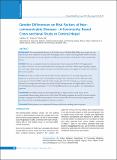Please use this identifier to cite or link to this item:
https://hdl.handle.net/20.500.14356/1803Full metadata record
| DC Field | Value | Language |
|---|---|---|
| dc.contributor.author | Adhikari, K | - |
| dc.contributor.author | Gupta, N | - |
| dc.contributor.author | Koshy, A K | - |
| dc.date.accessioned | 2023-05-23T06:58:25Z | - |
| dc.date.available | 2023-05-23T06:58:25Z | - |
| dc.date.issued | 2014 | - |
| dc.identifier.citation | AdhikariK., GuptaN., & KoshyA. K. (2014). Gender Differences on Risk Factors of Noncommunicable Diseases – A Community Based Cross-sectional Study in Central Nepal. Journal of Nepal Health Research Council. https://doi.org/10.33314/jnhrc.v0i0.495 | en_US |
| dc.identifier.issn | Print ISSN: 1727-5482; Online ISSN: 1999-6217 | - |
| dc.identifier.uri | http://103.69.126.140:8080/handle/20.500.14356/1803 | - |
| dc.description | Original Article | en_US |
| dc.description.abstract | Abstract Background: Non-communicable diseases are the leading causes of death globally, killing more people each year than all other causes combined. As many other developing countries, Nepal is also facing double burden of diseases. The aim of present study was to assess gender wise differences on prevalence of risk factors of non-communicable diseases. Methods: This was a community based cross sectional study which was based on WHO’s STEP approach for surveillance risk factors of non-communicable diseases among males and females. Multi-staged sampling technique was used to get required study sample. Descriptive and inferential statistics were applied to compare the risk factors between two genders. Results: More than two-fifth of male and one-fifth of female respondents were currently using tobacco. The proportion of current alcohol users was found higher among the male respondents (28.6%) than their female counterparts (13.6%) (P<0.001). Only 35 (5.3%) of males and 13 (2.3%) of females were found consuming adequate (=5 serving) intake of fruits per day. Study revealed that hypertension was slightly higher in male 165 (24.8%) than their female counterparts 111 (19.3%) but differences between two genders were statistically not significant. Conclusions: The findings of present study suggest that there is high prevalence of risk factors of noncommunicable diseases among both sexes in central Nepal. The finding emphasises the need for a focused national strategies targeting to tackle this modern epidemic of non-communicable diseases by incorporating primordial prevention activities to all adult population irrespective to gender.  Keywords: Blood pressure; non-communicable diseases; risk factors; smoking; waist to hip ratio. | en_US |
| dc.language.iso | en | en_US |
| dc.publisher | Nepal Health Research Council | en_US |
| dc.relation.ispartofseries | May-Aug, 2014;495 | - |
| dc.subject | Blood pressure | en_US |
| dc.subject | Non-communicable diseases | en_US |
| dc.subject | Risk factors | en_US |
| dc.subject | Smoking | en_US |
| dc.subject | Waist to hip ratio | en_US |
| dc.title | Gender Differences on Risk Factors of Noncommunicable Diseases – A Community Based Cross-sectional Study in Central Nepal | en_US |
| dc.type | Journal Article | en_US |
| local.journal.category | Original Article | - |
| Appears in Collections: | Vol. 12 No. 2 Issue 27, May - Aug 2014 | |
Files in This Item:
| File | Description | Size | Format | |
|---|---|---|---|---|
| 495-Article Text-752-1-10-20141121.pdf | Fulltext Download | 166.16 kB | Adobe PDF |  View/Open |
Items in DSpace are protected by copyright, with all rights reserved, unless otherwise indicated.
